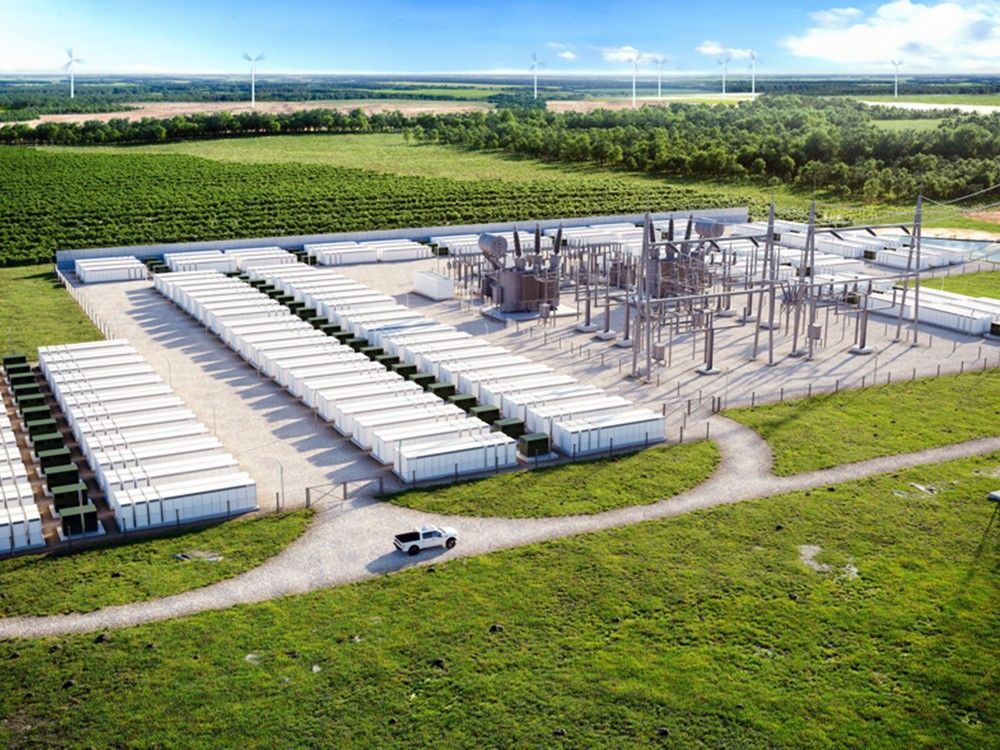You are using an out of date browser. It may not display this or other websites correctly.
You should upgrade or use an alternative browser.
You should upgrade or use an alternative browser.
The Politics of Climate Change: Green New Deal And Other Madness
- Thread starter Ennio
- Start date
Them records are a-breakin'.
Back to EV Realities (climate 101's)
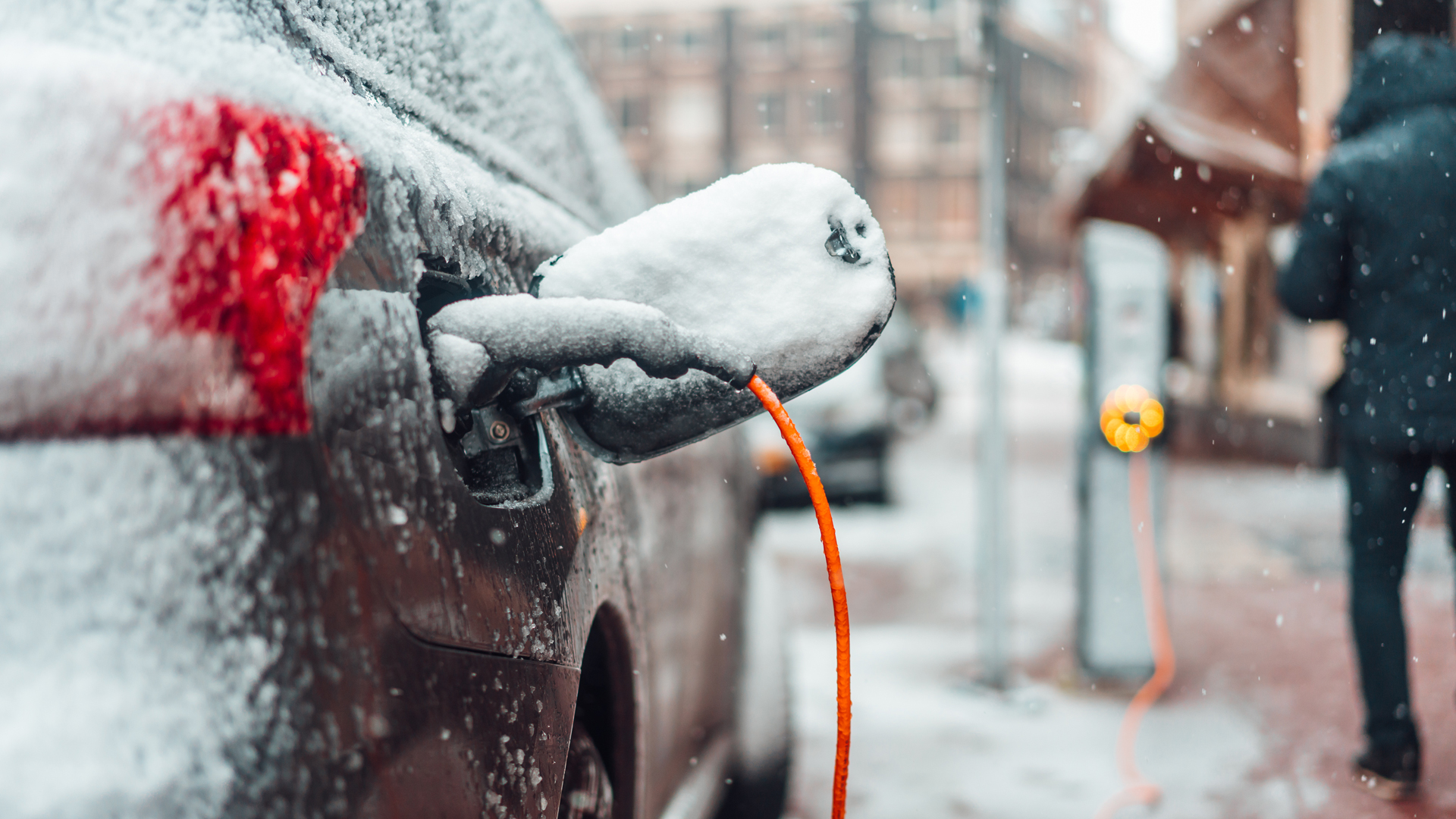
 www.rebelnews.com
www.rebelnews.com

Electric vehicles lose up to 30% of their range in winter weather, says firm
Electric vehicles boast a higher efficiency relative to gas vehicles, preventing them from using wasted heat to warm up the cabin and maintain passenger comfort below freezing.
Steve once had a criminal disposition, however he now has the revised title of Honorable Minister.Electric vehicles lose up to 30% of their range in winter weather, says firm
Electric vehicles boast a higher efficiency relative to gas vehicles, preventing them from using wasted heat to warm up the cabin and maintain passenger comfort below freezing.
Despite the push by the Trudeau Liberals to have all new vehicles sold in Canada be electric vehicles (EVs) by 2035, a recent study uncovered that they could lose up to 30% of their range in freezing temperatures, possibly jeopardizing that target.
According to Seattle-based Recurrent, which measured range loss in 7,000 EVs at temperatures between -7°C and -1°C {try -15°C to 30°C and see how that works out} the Jaguar I-Pace lost 3% of its range while the Volkswagen ID.4 lost 30% at those temperatures.
Recurrent researcher Liz Najmam cited the energy needed to heat the EV's cabin during the winter for its decreased range.
She said its higher efficiency relative to gas vehicles prevents it from using wasted heat to warm up the cabin and maintain passenger comfort.
“If you've ever touched the hood of a gas car, you know it's really hot after it's been driving,” said Najman. “And that's because gasoline engines are super inefficient, and so they create all of this waste heat.”
She added that when you turn a gas vehicle on, you funnel all its heat from the engine to the cabin, whereas EVs generate heat in other ways.
When EVs use more energy to heat the vehicle, that's less juice from the battery that won't go toward the range. However, some vehicles use more efficient heat pumps to warm the cabin, leaving more energy allocated to the distance travelled.
Sudbury, Ontario native Steve Holmik drives a Tesla Model Y, and he loses upwards of 50% of his range in cold temperatures.
“Around town, the range impact is negligible,” said Holmik. “It's nice and warm when you get inside. It's no different to essentially driving a gas vehicle.”
But he attributes that Canada's winter weather could be an issue for people who drive long distances, especially if they travel where electric charging infrastructure is in short supply {like anywhere outside a city}.
“Especially once you get north of Sudbury {for those who know about north of Sudbury} , the infrastructure isn't there,” said Holmik. “If you go to Timmins, you'd be lucky to find a Level 2 charger.”
However, some vehicles, like Teslas, have a battery preconditioning feature that warms up the car battery before reaching a charger, which quickens charging times.
Holmik said by preheating his car while it's still plugged in at his house or using a fast charger {wonder what the end game on electrical costs for charging will eventually cost?}, he enhances range loss by upwards of 20%.
Federal Environment Minister Steven Guilbeault {a Marxcissists} proposed before Christmas that 20% of all passenger vehicles sold in Canada in 2026 must be electric.
Passenger vehicles account for half of all road transportation emissions and about 10% of Canada's total emissions across all sectors.
The Government of Canada is pushing for six million more zero-emission passenger vehicles by 2030. Before the COVID pandemic, annual sales in Canada of cars and light trucks were under two million units, with the total stock of such vehicles in Canada being about 23 million.
Brian Kingston, president and CEO of the Canadian Vehicle Manufacturers' Association, cautioned that the federal government should build the necessary infrastructure for electric vehicles before regulating sales.
He said Canada's infrastructure is not on track to support a growing fleet — and those who will be driving the new cars.
“The vehicles are coming, but we need a supercharged effort to help marketers make that purchase and make it easy, convenient, and accessible.”
Herbal witch
Jedi Master
First UK, now us!!!! Dear lord, won't they ever learn?????
In the Spirit of Reconciliation with the Natives and First Nations, here is a project that will blow us all out of future development in the spirit of feasible and responsible leadership and reliable permanent resources! Good grief, have they learned nothing from the layoffs in England with a similar project????
The project "promises" jobs and enough power to supply a small city's needs. Now, there is nothing here that specify what a small city is by population or the standard needs, nor how long that would last, nor anything else beside just jobs - but nothing says that jobs will become permanent! How will those batteries be recharged? Is it by water dams, wind turbines, other???? They only mention small modular reactors. What kind? Are they like a generator? Will the generator be free or do they have to pay for it? Who will service those? The article does not specify. This is a scary thought - they give a huge pat on the back to the Natives People, but don't say exactly how it will be done or how much it will cost to the home owner???? I would want to know if my region would receive such an offer.
We are all aware of what Ford is doing to Ontario, but now he has really pushed the bucket pretty far - not only is he jeopardizing the lives and livelihood of Natives, but also the economic rehabilitation of the region.
I fear the First Nation is on the path of being lab rats! That is my feeling upon reading that article.
 en.wikipedia.org
en.wikipedia.org
Michelle Ruby
Published Feb 10, 2023 • Last updated 5 hours ago • 2 minute read
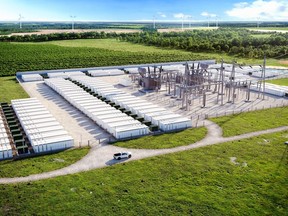 An artist's rendering of the Oneida Energy storage project proposed for Six Nations of the Grand River.
An artist's rendering of the Oneida Energy storage project proposed for Six Nations of the Grand River.
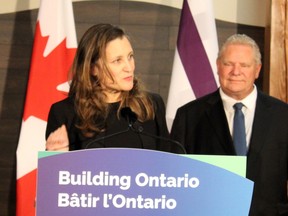
OHSWEKEN The federal and provincial governments are investing in the construction of what they say will be the largest battery storage project in Canada built on Six Nations of the Grand River.
The 250-megawatt Oneida Energy storage project will draw and store electricity from the provincial grid – more than 80 per cent of which is emissions-free – when power demand is low and return the power to the system when demand is high.
On Friday, Deputy Prime Minister Chrystia Freeland was in Ohsweken, along with Ontario Premier Doug Ford, to announce a $50-million federal investment in the project.
“When our two governments work together, in partnership with Indigenous communities, we can help to build a stronger economy and a more sustainable province,” said Freeland.
The premier described the project as a “game-changer” and said it would help provide affordable clean energy to the province’s growing population.
The project, which is expected to begin operations in 2025, will provide enough power to meet the peak demand of a small city, such as Oshawa, and reduce carbon emissions by 2.2- to 4.1-million tonnes, which is equivalent to taking up to about 40,000 cars off the road, the government said.
Aside from the federal funding, the project will be supported by the Canada Infrastructure Bank, which has pledged $170 million, and the Ontario government. The facility is being developed by Six Nations of the Grand River Development Corp., Northland Power Inc., NRStor Inc. and Aecon Group Inc.
Matt Jamieson, chief executive of the Six Nations development corporation, said the project is “all about the creation of jobs” for the community.
“We have a $1.6-billion infrastructure gap and need to take control of our destiny,” said Jamieson. “We’re going to put our people to work. This is going to have a great socio-economic impact for a community that really needs it.”
Annette Verschuren, chair and CEO of NRStor Inc., said work on the project began in 2018 and was interrupted by the pandemic, supply chain problems and other issues.
“It’s one of those projects you thought would never end. We’ve dreamed of this moment.”
Ford said the province has directed the Independent Electricity System Operator to enter into a 20-year deal with the project as part of its push for more clean energy supply.
“I’m thrilled to see so many great partners come together to build this world-class project that will provide affordable, clean energy for generations to come,” he said. “With a growing population and as we secure game-changing investments in our economy, our government is supporting innovative and bold energy solutions to meet the increasing demand for power, including battery storage and small modular reactors.”
Freeland said the project is an “essential part of the path to reconciliation” with Indigenous groups.
“I think we recognize that Canada is an amazing country, but we have an original sin and reconciliation is the path forward.”
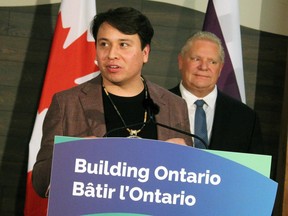
Mark Hill, elected Chief of Six Nations of the Grand River, said the project is “all about creating jobs.”
When questioned about whether the Haudenosaunee Confederacy has been consulted about the project, Hill said there was “every opportunity for them to join in.”
“It’s time, once and for all, for all of us to get in one room,” he said. “We’re looking for way to further build relationships.”
..........................................................................
Your thoughts please!
In the Spirit of Reconciliation with the Natives and First Nations, here is a project that will blow us all out of future development in the spirit of feasible and responsible leadership and reliable permanent resources! Good grief, have they learned nothing from the layoffs in England with a similar project????
The project "promises" jobs and enough power to supply a small city's needs. Now, there is nothing here that specify what a small city is by population or the standard needs, nor how long that would last, nor anything else beside just jobs - but nothing says that jobs will become permanent! How will those batteries be recharged? Is it by water dams, wind turbines, other???? They only mention small modular reactors. What kind? Are they like a generator? Will the generator be free or do they have to pay for it? Who will service those? The article does not specify. This is a scary thought - they give a huge pat on the back to the Natives People, but don't say exactly how it will be done or how much it will cost to the home owner???? I would want to know if my region would receive such an offer.
We are all aware of what Ford is doing to Ontario, but now he has really pushed the bucket pretty far - not only is he jeopardizing the lives and livelihood of Natives, but also the economic rehabilitation of the region.
I fear the First Nation is on the path of being lab rats! That is my feeling upon reading that article.
Ohsweken, Ontario - Wikipedia
Independent Electricity System Operator - Wikipedia
......................................................................................................Ottawa to invest $50M to build Canada's largest battery storage facility at Six Nations
Author of the article:Michelle Ruby
Published Feb 10, 2023 • Last updated 5 hours ago • 2 minute read


OHSWEKEN The federal and provincial governments are investing in the construction of what they say will be the largest battery storage project in Canada built on Six Nations of the Grand River.
The 250-megawatt Oneida Energy storage project will draw and store electricity from the provincial grid – more than 80 per cent of which is emissions-free – when power demand is low and return the power to the system when demand is high.
On Friday, Deputy Prime Minister Chrystia Freeland was in Ohsweken, along with Ontario Premier Doug Ford, to announce a $50-million federal investment in the project.
“When our two governments work together, in partnership with Indigenous communities, we can help to build a stronger economy and a more sustainable province,” said Freeland.
The premier described the project as a “game-changer” and said it would help provide affordable clean energy to the province’s growing population.
The project, which is expected to begin operations in 2025, will provide enough power to meet the peak demand of a small city, such as Oshawa, and reduce carbon emissions by 2.2- to 4.1-million tonnes, which is equivalent to taking up to about 40,000 cars off the road, the government said.
Aside from the federal funding, the project will be supported by the Canada Infrastructure Bank, which has pledged $170 million, and the Ontario government. The facility is being developed by Six Nations of the Grand River Development Corp., Northland Power Inc., NRStor Inc. and Aecon Group Inc.
Matt Jamieson, chief executive of the Six Nations development corporation, said the project is “all about the creation of jobs” for the community.
“We have a $1.6-billion infrastructure gap and need to take control of our destiny,” said Jamieson. “We’re going to put our people to work. This is going to have a great socio-economic impact for a community that really needs it.”
Annette Verschuren, chair and CEO of NRStor Inc., said work on the project began in 2018 and was interrupted by the pandemic, supply chain problems and other issues.
“It’s one of those projects you thought would never end. We’ve dreamed of this moment.”
Ford said the province has directed the Independent Electricity System Operator to enter into a 20-year deal with the project as part of its push for more clean energy supply.
“I’m thrilled to see so many great partners come together to build this world-class project that will provide affordable, clean energy for generations to come,” he said. “With a growing population and as we secure game-changing investments in our economy, our government is supporting innovative and bold energy solutions to meet the increasing demand for power, including battery storage and small modular reactors.”
Freeland said the project is an “essential part of the path to reconciliation” with Indigenous groups.
“I think we recognize that Canada is an amazing country, but we have an original sin and reconciliation is the path forward.”

Mark Hill, elected Chief of Six Nations of the Grand River, said the project is “all about creating jobs.”
When questioned about whether the Haudenosaunee Confederacy has been consulted about the project, Hill said there was “every opportunity for them to join in.”
“It’s time, once and for all, for all of us to get in one room,” he said. “We’re looking for way to further build relationships.”
..........................................................................
Your thoughts please!
Now Killary joins the fray by proposing to ban cash in order to fight against climate change!
Now Killary joins the fray by proposing to ban cash in order to fight against climate change!
I liked one of the comments in that tweet:
"I have a better idea…
Let’s get rid of all of our corrupt [psycopathic] political mouthpieces first and see if that solves the problem."
Or better yet, take cash away only from politicians, and we only need a digi-ID for all of the politicians and governments so we can track and trace them, since they work for us, thus needing to be accountable to us.I liked one of the comments in that tweet:
"I have a better idea…
Let’s get rid of all of our corrupt [psycopathic] political mouthpieces first and see if that solves the problem."
Listen to the following short video. It is titled "Which is it...NBA or NFL? Watch because it has to do with the comment above:Or better yet, take cash away only from politicians, and we only need a digi-ID for all of the politicians and governments so we can track and trace them, since they work for us, thus needing to be accountable to us.
Electricity shortages predicted from 2027, with threats of blackouts on east coast [Australia]
More investment is urgently needed to modernise Australia's energy grid, or the continued closure of coal power stations could lead to electricity shortages and blackouts on the east coast by 2027, according to a forecast from the Australian Energy Market Operator.AEMO CEO Daniel Westerman said "reliability gaps" would begin to emerge from 2025, until all states and territories in the national energy market would "breach" reliability standards in 2027, without urgent investment in generation and the grid.
Westerman said the breaches could be attributed to at least five coal power stations - totalling about 13 per cent of the market's total capacity - expected to retire.
"Urgent and ongoing investment in renewable energy, long-duration storage and transmission is needed to reliably meet demand from Australian homes and businesses," Westerman said.
He said short-term reliability gaps in South Australia and Victoria had been filled by "new gas, wind and battery developments".
"The NEM (national energy market) has a strong pipeline of proposed generation and storage projects, totalling three times today's generation capacity, with large-scale solar, wind and batteries accounting for 86 per cent," Westerman said.
"Investment in firming generation, such as pumped hydro, gas and long-duration batteries, is critical to complement our growing fleet of weather-dependent renewable generation to meet electricity demand without coal generation."
AEMO was established in 2009 by the Council of Australian Governments to regulate the energy market, and is jointly owned by the federal and state governments, and industry.
Other experts said it was clear more action was needed on renewables.
"The good news is we are going to be okay for electricity supply this winter when Liddell closes," Nexa Advisory founder and former AGL public policy head Stephanie Bashir said.
"Over the longer term, this statement shows we are behind on building renewable generation and transmission. We need to get on with it, on a massive scale."
Climate Energy Finance director Tim Buckley said there had clearly been significant progress on decarbonising the energy grid in the past six months.
"AEMO flags a staggering 209 gigawatts pipeline of new firmed renewables project proposals – battery, solar and wind – worth over $250 billion in total, highlighting the massive, once in a century regional employment and investment opportunities ahead for Australia from decarbonisation," he said.
"However, with only 10 gigawatts committed, there is a clear need for sustained policy certainty, accelerated grid transmission investment, expedited Renewable Energy Zones (REZ) and a continuation of the Federal-State cooperation we have seen since the election of the Albanese government."
Good luck with that, idiots.
In connection with this story - Sky News:
Koala habitats under ‘one heck’ of a threat from renewable land clearing: Murray
Sky News host Paul Murray says renewables are “one heck” of a threat to Koalas as bushland is cleared to make way for solar panels or wind farms.
“They, of course, became quite the focus of the rest of the world during the bushfires a few years ago when so many of them were impacted by the fires,” Mr Murray said.
“Guess what might be one heck of a threat to koalas – it ain’t bushfires … we learn today that renewable energy projects are a significant threat to koalas.
Sydney Morning Herald:
One in five developments threatening koala habitat are renewable energy projects
More than two dozen renewable energy projects lodged with the Commonwealth for assessment could damage precious koala habitat, posing a delicate environmental conundrum for the Albanese government.The environment department is assessing 140 developments that could threaten koala habitat, 29 of which are renewable energy projects alongside 50 coal and gas projects and 37 property developments.
[...]
The projects registered with the department that would threaten koala habitat would remove habitat trees for site development and access roads as well as potentially fragment the species’ natural range, which has already been decimated.
The sites, selected by the project proponents, will be assessed by state and federal governments, while Plibersek holds final say on development applications that affect threatened species.
When any of these projects progress to final approvals, scrutiny of her actions will be intense, following the listing of koalas as a threatened species in 2022.
[...]
“If you want your kids and grandkids to be able to see koalas in the wild, we have to change what we’re doing because in NSW we’re on a trajectory to no koalas by 2050.”
It is estimated as many as one-third of NSW’s koalas – about 10,000 animals – perished in the 2019-20 Black Summer bushfires and preceding drought, while Queensland’s population has shrunk by about 50 per cent in the past decade.
However, the Albanese government has set a legally binding goal to cut Australia’s greenhouse emissions 43 per cent by 2030 and one of the most significant sources of pollution cuts is forecast to come from an influx of clean energy replacing coal-fired electricity generation.
Climate Change and Energy Minister Chris Bowen has set a target to grow renewable energy from its current proportion of 30 per cent of the grid’s power to 82 per cent by the end of the decade. Bowen has said Australia will need to install 40 seven-megawatt wind turbines each month and install 22,000 500-watt solar panels a day, for the next eight years.
All this renewable energy must be located somewhere, which means at least a likely big jump in the list of 18 wind projects, seven solar farms and four hydroelectric projects registered with the federal government as a potential threat to koala habitat.
The challenge for the government in balancing the need for clean power with conservation will be magnified further by the 10,000 kilometres Bowen says is needed, at a minimum, to link all the far-flung wind and solar farms into the existing grid.
 what absolute psychos.
what absolute psychos. bet the Koalas can't wait for the 'rocks'... they have a better chance of long term survival with that option.
Olivierlejardinier
Jedi Council Member
Western news are mentioning this today ( Source 23 feb 2023 ), they're still pushing hard...
Looking at the maps, should our Chinese friends be worried ?
Estimated risks up to 2050...
Looking at the maps, should our Chinese friends be worried ?
Estimated risks up to 2050...
"New dataset exposes economic hubs most at risk from extreme weather and climate change"
"This week, in response to demand from investors for data on sub-sovereign and regional risk, XDI has released the second in our Benchmark Series, a dataset called Gross Domestic Climate Risk. This dataset provides a unique comparison of the risk of damage to the built environment from extreme weather and climate change in states, provinces and territories around the world.
.../...
Reviewing the results, three conclusions are very clear.
The first is that physical climate risk must be elevated in the attention of investors, lenders and companies. Transition risk is material for many, but the extent and duration of physical risk is yet to be fully grasped. In the scenarios developed by the Network for Greening the Financial System, deployed by ESG analysts the world over, physical risk outweighs transition risk in all scenarios and all time frames.
The second conclusion is that the stability and security of the global economy rests on urgently prioritising climate resilient investment frameworks and unlocking financing for adaptation to the impacts of climate change.
The final conclusion is that accelerating decarbonisation is a necessary business strategy. Physical risks will intensify under all scenarios, but the damage results presented in the Gross Domestic Climate Risk dataset can be reduced by meeting Net Zero commitments quickly, on a pathway consistent with avoiding 1.5 degrees of global average warming. "
80% of the top 50 most at-risk states and provinces in 2050 are in China, the United States or India.
Regions in focus: what does the data show?
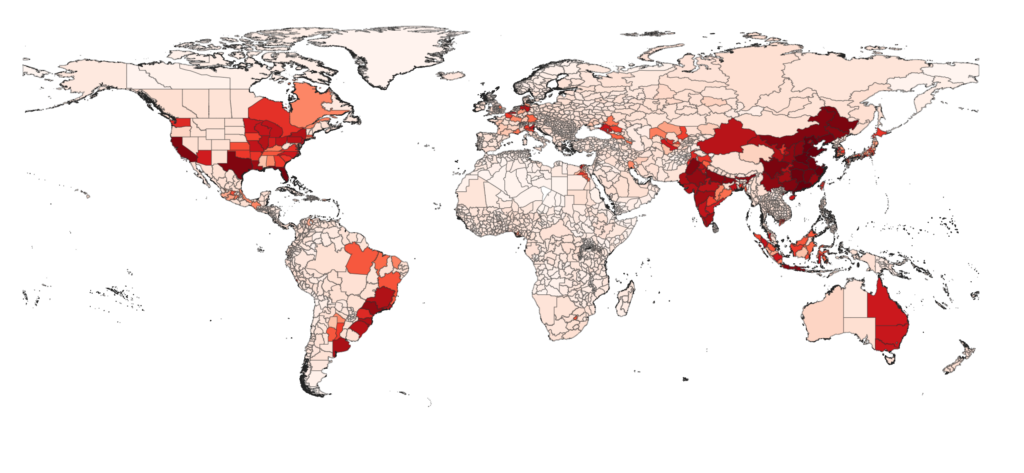
Global heatmap
A global picture of 2,600+ territories in this dataset, coloured to show areas with higher Aggregated Damage Ratio in 2050."
Here a zoom on the US :
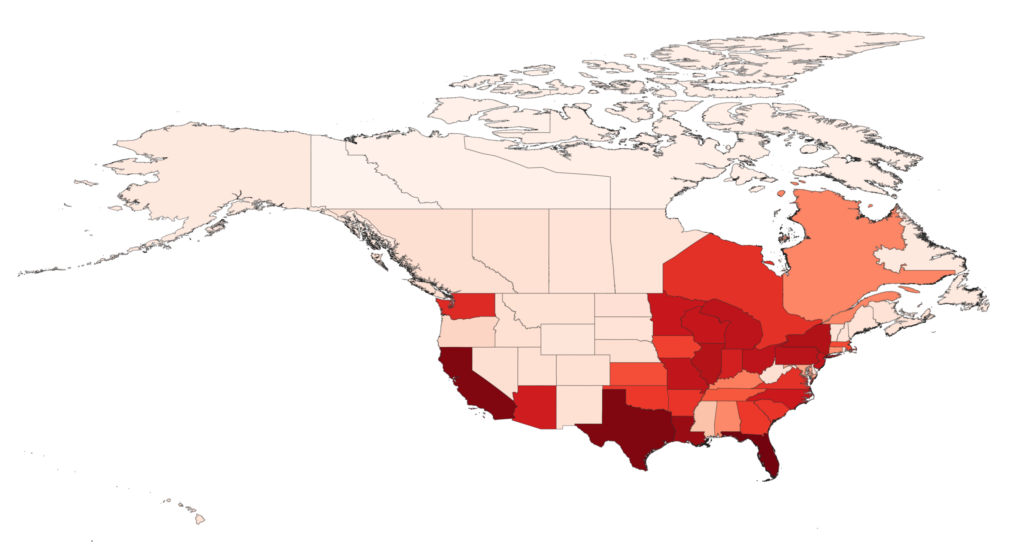
And China :
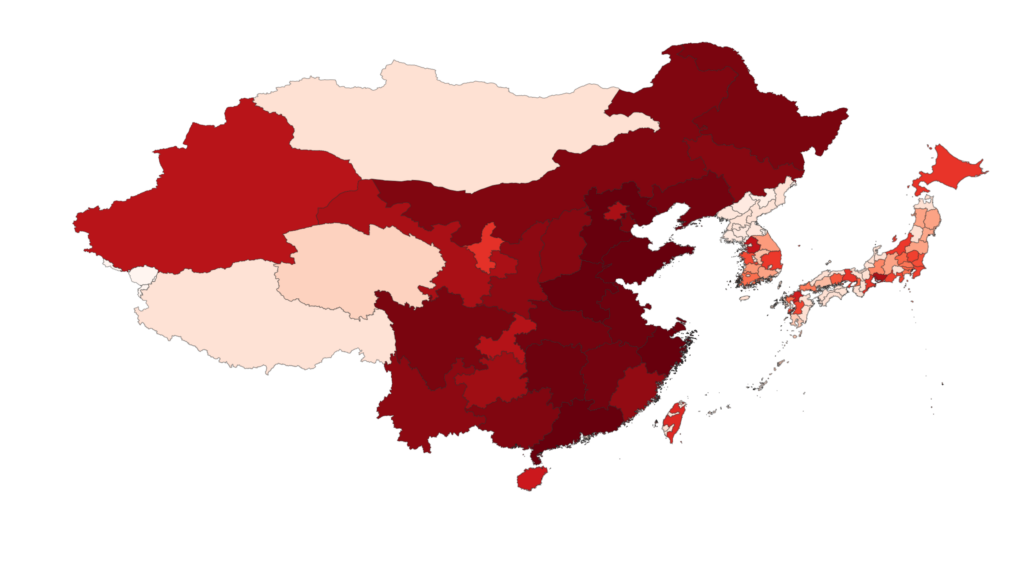
Europe finds itself in a tough spot as European businesses keep being hit by high energy bills despite the drop in global energy prices, due to the self-imposed restrictions on cheap Russian energy.
On one side, energy-intensive businesses across Europe have started to close plants permanently and move production to countries where labour and energy is cheaper like China to better serve the demand in those regions. On the other side, the US is rolling out the Inflation Reduction Act which allows European companies to benefit from tax breaks for investing in clean energy projects in America, discouraging new investments in the Old Continent in favour of the US.
This translates in mass layoffs in Europe and ultimately in the destruction of the manufacturing base which accounts for a substantial share of GDP in countries such as Germany and Italy. As an example, German chemical maker BASF recently announced it would permanently wind down several plants in Germany and lay off 2600 jobs due to energy costs soaring to €3.2bn while it invests in building new facilities in China.
This trend is also visible in the chart below comparing the number of automobiles exported by each country. China (red line) has seen the largest % increase since the start of covid while Germany (grey line) experienced the opposite trend with car exports in units dropping substantially.

On one side, energy-intensive businesses across Europe have started to close plants permanently and move production to countries where labour and energy is cheaper like China to better serve the demand in those regions. On the other side, the US is rolling out the Inflation Reduction Act which allows European companies to benefit from tax breaks for investing in clean energy projects in America, discouraging new investments in the Old Continent in favour of the US.
This translates in mass layoffs in Europe and ultimately in the destruction of the manufacturing base which accounts for a substantial share of GDP in countries such as Germany and Italy. As an example, German chemical maker BASF recently announced it would permanently wind down several plants in Germany and lay off 2600 jobs due to energy costs soaring to €3.2bn while it invests in building new facilities in China.
This trend is also visible in the chart below comparing the number of automobiles exported by each country. China (red line) has seen the largest % increase since the start of covid while Germany (grey line) experienced the opposite trend with car exports in units dropping substantially.
XPan
The Living Force
"Climate Skeptics should be in prison forever" 
It's almost impossible for me trying to "feel that reasoning from within" (It is my personal way of trying to get an picture, of how such thinking could feel like, deep from within; the reasoning, the core behind, the... darkness in it - if there is any resonance I could make out) - but its too much. I just don't get it.
Yet imagine; people who just look like normal dudes... barfing out such sinister, utter BS.


It's almost impossible for me trying to "feel that reasoning from within" (It is my personal way of trying to get an picture, of how such thinking could feel like, deep from within; the reasoning, the core behind, the... darkness in it - if there is any resonance I could make out) - but its too much. I just don't get it.
Yet imagine; people who just look like normal dudes... barfing out such sinister, utter BS.
The Text translated says:
University professor wants to "lock climate sceptics away forever"
11.02.2023
A professor at the Vienna University of University of Natural Resources and Applied Life Sciences (BOKU) collar. He addressed the following words to "climate crisis deniers": "Lockdown forever. words to "climate crisis deniers": "Lockdown forever. We will lock you all up".
Hi_Henry
The Living Force
Huummmm, this is interesting.
Sort of like the EPA with its air quality measurements in East Palestine.
Sort of like the EPA with its air quality measurements in East Palestine.


